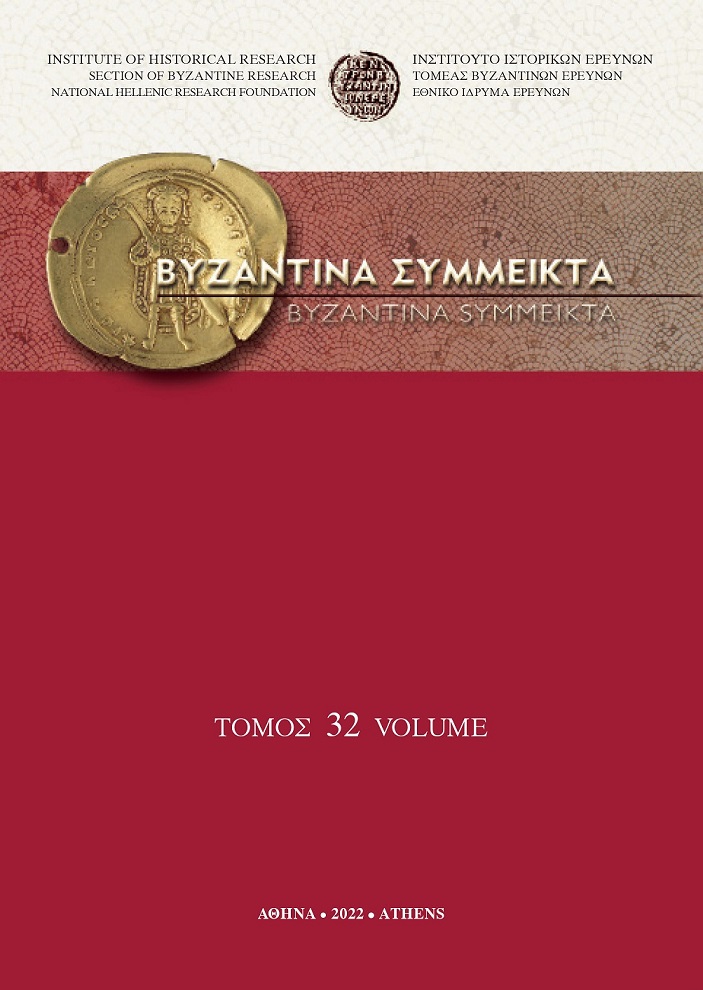Byzantine Textual Sources for Climatic and Environmental Developments

Περίληψη
ΒΥΖΑΝΤΙΝΕΣ ΚΕΙΜΕΝΙΚΕΣ ΠΗΓΕΣ ΣΧΕΤΙΚΑ ΜΕ ΤΙΣ ΚΛΙΜΑΤΟΛΟΓΙΚΕΣ ΚΑΙ ΤΙΣ ΠΕΡΙΒΑΛΛΟΝΤΟΛΟΓΙΚΕΣ ΑΛΛΑΓΕΣ
Το παρόν άρθρο πραγματεύεται την πρόοδο που έχει πραγματοποιηθεί στη διερεύνηση των βυζαντινών κειμενικών πηγών από ιστορική και παλαιοκλιματολογική άποψη. Αναλύει γενικές έννοιες που επηρεάζουν την ιδεολογική προοπτική των αναφορών στον καιρό, το κλίμα και τις σχετικές καταστροφές, στο πλαίσιο των ειδών των βυζαντινών κειμενικών πηγών που τις περιλαμβάνουν. Στη συνέχεια, παρουσιάζει επισκόπηση των τεκμηριωμένων παλαιοκλιματικών στοιχείων που συναντώνται για το Βυζάντιο, δίνοντας έμφαση στις κατηγορίες των φαινομένων που αναφέρονται στις πηγές. Τέλος, συζητά προβλήματα που σχετίζονται με την ανάλυση και την ερμηνεία των στοιχείων με όρους ιστορικής κλιματολογίας του Βυζαντίου και, τελικά, βυζαντινής περιβαλλοντικής ιστορίας.
Λεπτομέρειες άρθρου
- Πώς να δημιουργήσετε Αναφορές
-
TELELIS, I. (2022). Byzantine Textual Sources for Climatic and Environmental Developments. Βυζαντινά Σύμμεικτα, 32, 17–41. https://doi.org/10.12681/byzsym.27282
- Τεύχος
- ΒΥΖΑΝΤΙΝΑ ΣΥΜΜΕΙΚΤΑ 32
- Ενότητα
- Άρθρα

Αυτή η εργασία είναι αδειοδοτημένη υπό το CC Αναφορά Δημιουργού – Μη Εμπορική Χρήση – Παρόμοια Διανομή 4.0.
Οι συγγραφείς των άρθρων που δημοσιεύονται στα ΒΥΖΑΝΤΙΝΑ ΣΥΜΜΕΙΚΤΑ διατηρούν τα δικαιώματα πνευματικής ιδιοκτησίας επί των άρθρων τους, δίνοντας στο περιοδικό το δικαίωμα της πρώτης δημοσίευσης. Άρθρα που δημοσιεύονται στα ΒΥΖΑΝΤΙΝΑ ΣΥΜΜΕΙΚΤΑ μπορούν να χρησιμοποιούνται ελεύθερα, χωρίς δικαίωμα τροποποίησης (δημιουργία παράγωγου έργου) με αναφορά στο συγγραφέα και στην πρώτη δημοσίευση για μη κερδοσκοπικούς σκοπούς(άδεια Creative Commons 4.0). To Εθνικό Ίδρυμα Ερευνών διατηρεί το δικαίωμα να δημοσιεύει, να αναπαραγάγει, να παρουσιάζει στο κοινό, να διανέμει και χρησιμοποιεί άρθρα που δημοσιεύονται στα ΒΥΖΑΝΤΙΝΑ ΣΥΜΜΕΙΚΤΑ σε οποιοδήποτε μέσο και μορφή είτε μεμονωμένα είτε ως μέρη συλλογικών έργων, για όλο το χρόνο διάρκειας προστασίας της πνευματικής ιδιοκτησίας και για όλες τις χώρες του κόσμου. Αυτό περιλαμβάνει ενδεικτικά και όχι αποκλειστικά, το δικαίωμα δημοσίευσης των άρθρων σε τεύχη του περιοδικού ΒΥΖΑΝΤΙΝΑ ΣΥΜΜΕΙΚΤΑ, αναπαραγωγής και διανομής μεμονωμένων αντιγράφων των άρθρων, αναπαραγωγής ολόκληρων των άρθρων σε άλλη έκδοση του ΕΙΕ, και αναπαραγωγής και διανομής των άρθρων ή περίληψης αυτών με χρήση πληροφορικού συστήματος αποθετηρίου.



